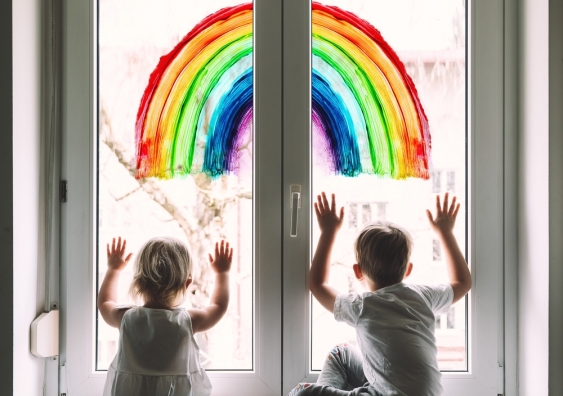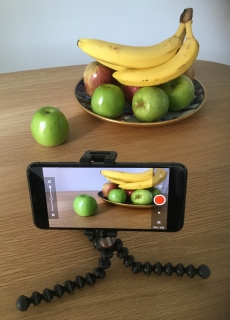Adapting theatre to digital learning: The value of play and creativity in isolation
Making art is another way children can find contentment in isolation.

Dr Bryoni Trezise has watched her primary-school aged daughter have a three hour ‘playdate’ via Skype during this COVID-19 crisis.
Four children on two screens moved from Barbies, to dress ups and then all ate a meal together, the senior lecturer in Theatre and Performance in the School of the Arts and Media at UNSW revealed.
“It wasn’t only time that flew – space changed too,” she says. “I watched them negotiate the singular ‘world’ that emerged from two physical ones. Tonight there is a kids’ birthday party on Zoom. We’re wearing party hats and we’ll work out the rest of the rules when we get there.”
Dr Trezise says possibly the only positive thing to emerge from the COVID19 crisis is the really strong sense that culture is infinitely adaptive.
She says we can see this in the myriad ways digital life is reorganising and sustaining our social worlds. New forms of ritualising, commemorating and connecting are being built every day during this crisis.
“We’ve seen Italians singing on balconies, Spanish rounds of applause for healthcare workers,” she says. “We’ve seen Zoom parties, Skype happy hours, viral TikTok mashups. For the children, neighbourhoods are popping up with socially distant teddy bear hunts and rainbow windows. There are infinite online tutorials in storytelling, puppetmaking, dancing, drumming, you name it.”

Dr Trezise is working on a research project titled The Viral Child – which examines how young people represent themselves in performance-based digital media.
Historically, children and young people have been positioned as consumers of content about them, she says. But the accessibility of digital technology means that not only are new ideas about childhood being expressed, but new cultural literacies are being shared and generated in the process.
“And these are all being created by kids. In COVID-19, for instance, we’ve seen a dramatic uptake of platforms such as TikTok and Instagram being used by kids to lyp-synch, parody, remix and mashup their way through the trials of home-schooling and isolation.
“These are hugely comedic self-representations that go viral not only because they are funny, but because they showcase ways to reflexively process the pandemic as well as build acts of togetherness – so essential for mental health and wellbeing – while staying apart.”
Dr Trezise says these essentially playful acts show how empowered young people are in leading the types of cultural and social change that communities need to see.
The senior lecturer in Theatre and Performance says very young children learn through play, and theatre teaches us that play is the way to test out new selves.
“[It helps us] experiment with scenarios, rehearse difficult dynamics, express tricky feelings and move our bodies and our minds a little differently to ways we might normally,” she says.
“Theatre also teaches us to act in the moment. To follow a thread, act on an impulse and say ‘yes’ to an idea without knowing why or where it might take us.”
Dr Trezise says this kind of thinking (learning through play) might be quite different to the home-schooling schedules that many parents are reckoning with.
“But kids tend to be much more fluidly prepared to operate in this way.”
The children around us can help us re-learn play, she says.
“It is how we discover how to be in distinctly new times and circumstances. It helps us to tune in and decide when to hold onto old structures and routines and when to let new ones appear.”
Create a unique world
Another way the arts can help children cope with isolation is to make art.
Lecturer in Media Production in the School of the Arts and Media at UNSW Sydney, Alyssa Rothwell, has been making animation for 28 years.
“When making an animation I prefer to work with traditional art materials and techniques (paint, pencil, paper, wire) supported by technology rather than just using digital animation software,” she says.
“I think this is why I find animation to be a very generous creative medium, that offers up wonderful and unexpected outcomes.”
The artist/animator says animation is a universally understood form of communication that appeals to many people.

Create a simple animation. Credit: A. Rothwell
Although it can take 25 individual shots/images to create one second of animation, she says it is possible for children to bring inanimate objects to life with an understanding of the magic of “persistence of vision” and a few simple animation tools.
“It’s essential to have a simple brief, not too ambitious, and animate just one thing at a time,” she says.
“Starting with an iPad or iPhone and a stop motion animation app such as iStopMotion or Stop Motion Studio, time and patience, you can make an animation.”
The more ordinary the subject, the more extraordinary it is to see it come to life through animation, she says.
“Make an apple or a pencil move across the table by itself or bring your favourite toy to life, slowly waking up all the different parts of its body, one by one. Or put all the things in your pencil case on the table and have them return to the pencil case one by one. Older children may be able to retell the story of a simple nursery rhyme using everyday objects as characters.”
To create a unique world and bring that world to life is a very engaging process that stimulates innovation, problem solving, creativity, resourcefulness and the capacity for nimble shifts in thinking, she says.
“Making an animation can have a meditative effect on the animator. It is a very engaging and mostly solo activity. It can feel like you are in control of your own small world. A great opportunity to imagine and make the impossible possible. All of which feels very good if the world around you is changing quickly.”







